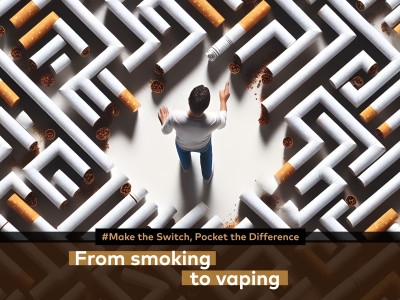More of their document in a bit, to start with have a guess where in the world CEH is based? Yes, America, but which bit? A clue here: pharma-funded Stanton Glantz and his pharma-funded Centre for Tobacco Control Research and Education (CTCRE) are based there...and the state must hold records for its inane anti-ecig public health campaigns. That is correct, California.
It’s possible to discount anything they have to say on the topic of electronic cigarettes at this point given the volume of nonsense that has come from that one state. But we won’t, we are going to pull their document to pieces.
The Guardian has unfortunately decided to cover their press release without analysis or counter argument. They write: “’For decades, the tobacco industry mounted a campaign of lies about cigarettes, and now these same companies claim that their e-cigarettes are harmless,’ said Michael Green, executive director of CEH. ‘Anyone who thinks that vaping is harmless needs to know that our testing unequivocally shows that it’s not safe to vape’.”
But Michael, you might say, NO ONE is claiming vaping is “safe” and what has the tobacco industry got to do with it seeing as the bulk of the market is made up of independent manufacturers? Michael won’t care, his position is not one grounded in science but rooted in dogma and bigotry.
“The CEH said its lab tests of 97 e-cigarette and vaping products revealed levels of formaldehyde and acetaldehyde that violated California’s safety standards. It said this was the first time e-cigarettes had been tested by simulating their real-world use.”
Unfortunately they fail to cite their testing in the report or produce any detail for the methodology. The document reads more like something that an advertising agency put together following the work it carried out helping to produce the California Department of Public Health’s (CDPH) woeful Still Blowing Smoke campaign.
The reference section certainly looks impressive – well, impressive in the way that a kid copy-pastes lots of things into a homework in order to make it look comprehensive. The trouble is they repeatedly cite the same items again and again, and that the three main pieces they rely on come from Glantz’s CTCRE and the CDPH.
Where they cite “Our testing” there is nothing of the sort – well, nothing appertaining to vaping. Clicking on the links reveals a NIOSH page for formaldehyde and one for acetaldehyde. No real world testing, just the reliance on one widely criticised study.
Time and again we have seen that aldehydes are only produced in dry-burn situations. So, if they did commission “an independent laboratory to test 97 e-cigarette products purchased from major retailers and online sellers” it certainly didn’t follow best practice.
This shouldn’t come as a surprise; the process was clearly engineered to obtain the outcome they wanted. By the end of the introduction they are already spouting guff and making specious links: “hundreds of e-cigarettes are sold in candy and dessert flavors and/or bright colors that appeal to teens and children. This has resulted in a major increase in nicotine poisoning incidents, especially among young children. CEH is calling on e-cigarette companies to end these deceitful and dangerous practices.”
The depiction of a mod is risible; the selection of the term “smoke” to describe “vape” is loaded and displays the bias. They rely on a market description by sticking to tobacco-owned cigalikes. They lay into “marketing”, “flavors” and the need to “protect youth” in a way that makes it feel Glantz wrote it – and not Caroline Cox.
It is odd then that with such a blinkered approach to presenting disinformation that they have the temerity to slate the industry for “deceptive marketing”. It is bizarre that they accuse vape companies of underhand tactics to “circumvent no-smoking rules” given that vaping is not smoking to all but the firmly closed eyes.
The report (purporting to expose high levels of toxins) then finds justification in calling for an outright ban on “sales of child-oriented flavours”. It betrays the immoral and corrupt prohibitionist mind-set at the heart of the Californian anti-vaping community.
It culminates in making that fatuous claim that ecigs do not help smokers quit. Vape meets, forums and researchers across the globe will marvel at such a stance given that all of the UK data supports the notion that ecigs are highly effective.
Many will see the release of this report as a knee-jerk response to the positivity gained from the recent Public Health England paper stating that vaping is 95% safer than smoking. Others might feel that it is nothing more than part of a continuing battle being fought by pharmaceutical companies to protect income from failing NRT products.
Dave Cross
Journalist at POTVDave is a freelance writer; with articles on music, motorbikes, football, pop-science, vaping and tobacco harm reduction in Sounds, Melody Maker, UBG, AWoL, Bike, When Saturday Comes, Vape News Magazine, and syndicated across the Johnston Press group. He was published in an anthology of “Greatest Football Writing”, but still believes this was a mistake. Dave contributes sketches to comedy shows and used to co-host a radio sketch show. He’s worked with numerous vape companies to develop content for their websites.
Join the discussion
Irish Harm Reduction Idiocy
As it passes a law to ban the sale of vapes to under-18s, the Irish Health Minister announces that he plans to seek further restriction on vaping that will impact on adult vapers and smokers
Portuguese Government Jeopardises Efforts
The Portuguese Government is jeopardising smoking cessation efforts with new legislation that will discourage smokers from switching to vapes
Portuguese Government Derailing Quitting
The Portuguese Government is jeopardising smoking cessation efforts with its new law, according to the World Vapers' Alliance
Stolen Samsung Warning
Lawyers acting on behalf of Samsung are reminding us not to sell you any of their batteries in case they’re used for anything and order us to warn you about stolen batteries because reasons












